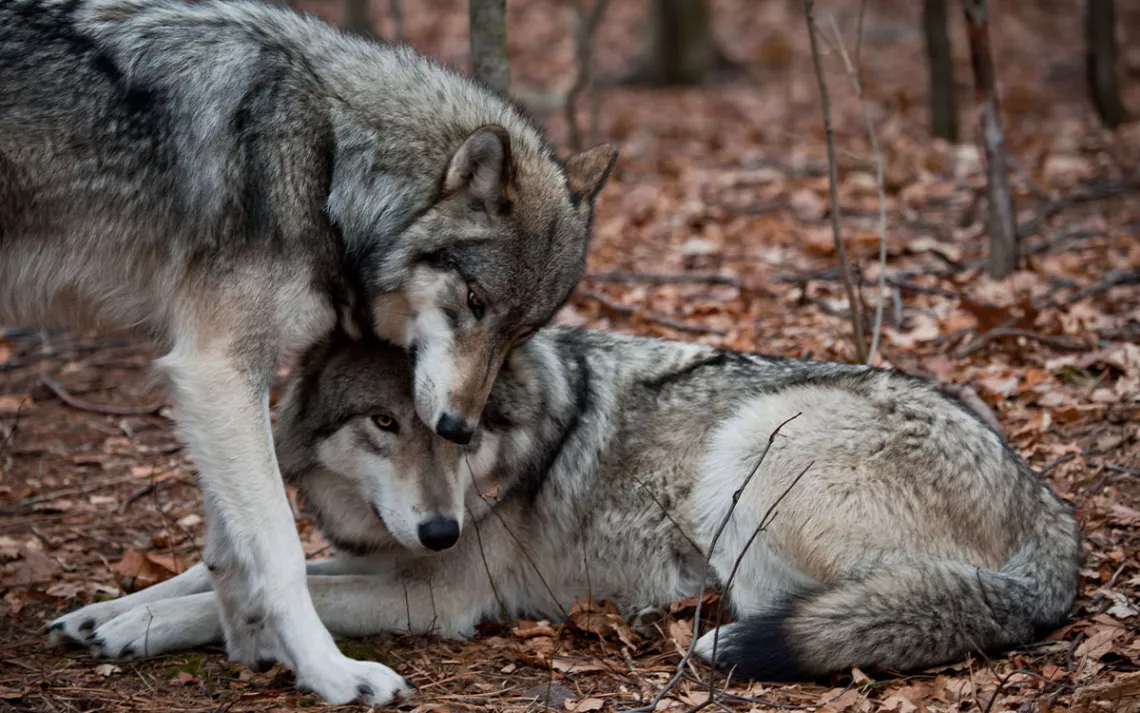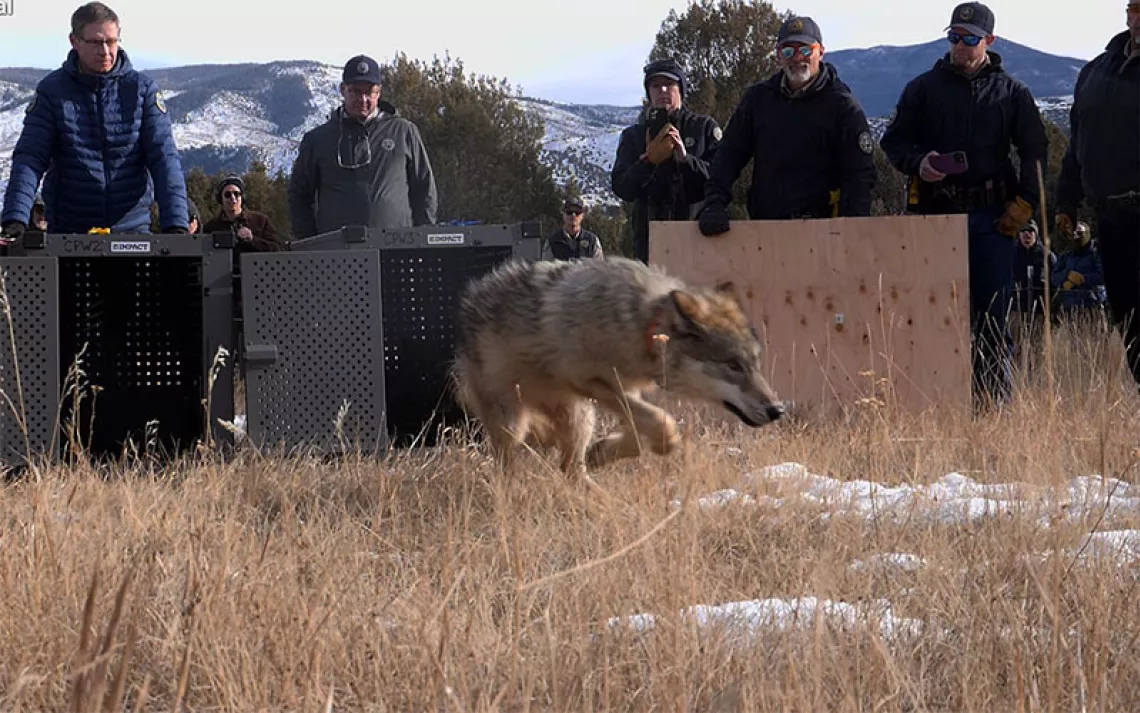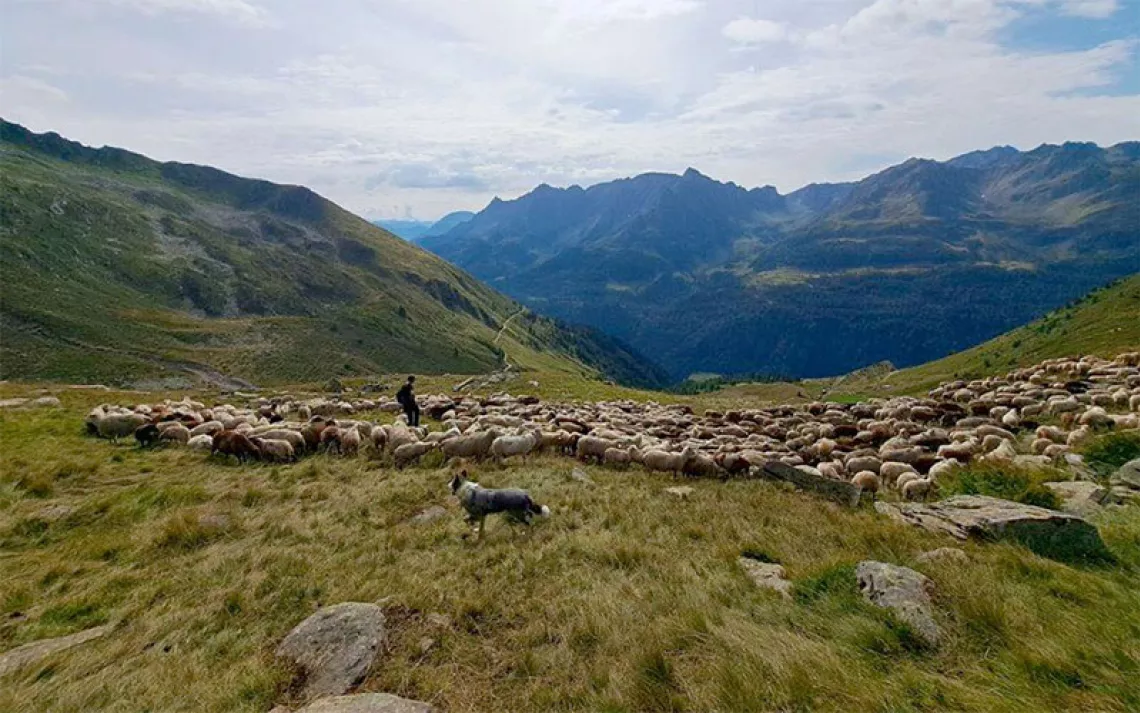Conservation Groups Sue to Stop Wolf Hunting in Idaho, Montana, and Wyoming
Wildlife organizations say federal agencies aren’t doing enough to protect wolves in the Rockies

Affectionate Grey Wolves. | Photo by RamiroMarquezPhotos/iStock
Earlier this week, more than a dozen conservation and wildlife organizations filed two separate lawsuits challenging the Biden administration’s refusal to reinstate Endangered Species Act protections for wolves in Idaho, Montana, Wyoming, and eastern Washington and Oregon. The lawsuits come in response to a rash of wolf killings, as hunters and poachers in the northern Rockies hunt wolves at rates and in ways not seen in a century. The groups say restoring ESA protections to wolves in these states is the only way to reverse what even US Fish and Wildlife admits will likely be a population decline if killing campaigns in these states continue.
“Idaho, Montana, and Wyoming have shown that wolf hostility drives the management of the species. Rather than relying on science to responsibly conserve their wolf populations, they're buying into myths and misinformation and stripping away safeguards,” Margie Robinson, a staff attorney with the Humane Society of the United States, told Sierra. “Federal protections are needed to ensure the viability of wolves in the region.”
At issue is the definition of the word “recovery.” The federal government set a limit of 150 wolves in each of the Rocky Mountain states for US FWS to consider recovery successful. The states have exceeded that number numerous times over, but this number was always a floor, not a ceiling, wildlife advocates argue. In addition, researchers’ latest science shows that recovery is so much more than numbers. It’s also about connectivity, genetic health, and the right numbers (high populations of breeding pairs, not just every individual wolf). In that regard, the Fish and Wildlife Service and states are failing, the conservation groups claim.
The Humane Society of the United States, along with the Center for Biological Diversity, is representing the Sierra Club in one of the lawsuits. The Western Environmental Law Center is leading another on behalf of 10 non-profit organizations throughout the West. Both cases, filed in Missoula, Montana, make similar arguments. They say that Idaho and Montana are overcounting wolf populations using questionable methods, which is causing the states to set unrealistically liberal hunting policies. In Wyoming, lawmakers have effectively created an invisible cage by allowing hunters to kill wolves by any method when they leave a small bubble surrounding Yellowstone National Park. Among these compounding threats, the groups say, USFWS is ignoring the effects of excessive killing on the genetic health of wolf populations. Essentially, state policies that allow torture, hunting, and trapping threaten over two decades of gray wolf recovery.
“The more that the wolf population is diminished in the Northern Rockies, the fewer wolves there are to disperse into neighboring states,” Amaroq Weiss, the senior wolf advocate at the Center for Biological Diversity, said. “If the protections are restored, that means no wolf hunting or trapping in those states that will allow those populations to grow.”
Junk Science
The Fish and Wildlife Service is required by law to use the best available science. Instead, it’s using old data and unreliable estimates from state agencies that have been reluctant to hand over the management of wolves. For its part, the Fish and Wildlife Service sees its role as preventing extinction. In the absence of such a threat, the agency thinks the best action is none at all.
“The Service conducted a comprehensive analysis using robust modeling that incorporated the best available data from federal, state and Tribal sources, academic institutions and the public,” stated a press release the agency released in February 2024. “The model assessed various threats, including human-caused mortality, existing regulatory mechanisms, and disease. The analysis indicates that wolves are not at risk of extinction in the Western United States now or in the foreseeable future.”
Researchers like Bob Crabtree of the Yellowstone Ecological Research Center and Scott Creel from Montana State University have long called out the misuse of the models used to estimate wolf populations in the region. In Idaho, the state uses a model, called the space to event model, that relies on randomly placed cameras to take motion-triggered images over a specific amount of time. But, in reality, the state wildlife agency is placing cameras near known wolf dens, leading to higher-than-normal rates of wolf photos. The end result implies that wolves are everywhere when, in fact, they’re just near their homes.
In Montana, the state wildlife agency uses the iPOM model, which veteran Yellowstone wolf biologist Doug Smith describes as “well-known and respected scientifically for estimating distribution (the area occupied).” But he cautions that the model “is not known to be a good abundance estimator.” In his analysis, Crabtree found that Montana could be inflating its wolf estimates by as much as 150 percent. “Why are they using this severity-biased method to estimate wolf population size when they can't detect changes from year to year?” Crabtree wondered.
Another finding that conservation groups say is problematic is the minimum number of wolves needed to establish healthy populations. Idaho would like to reduce its wolf population from just over 1,300 down to 500. Montana would like to reduce its wolf population from 1,000 down to 450.
Given the faulty ways in which the states count wolves, researchers say these numbers are dubious at best. Work by Bridgett M. vonHoldt, an evolutionary biologist at Princeton University, has shown that wolves in the region already suffer from a limited gene pool that’s much lower than wolf populations in the Great Lakes and eastern Canada. The Humane Society’s complaint states that vonHoldt “concluded that the gray wolf numbers ‘are below sizes predicted to be necessary to avoid long-term risk of extinction’ and that ‘larger wolf populations are necessary to ensure long-term adaptation and survival.”’
State Wolf Management is Controversial
Since 2021, state leaders in Idaho and Montana have passed laws that allow hunters to use chokehold snares, night goggles, aerial gunning, all-terrain vehicles, bait stations, hounds, and even bounties in the pursuit of killing wolves. Nick Gevock, the Sierra Club's Northern Rockies field organizer, says it’s the 1800s all over again in the northern Rocky Mountains. In total, Idaho, Montana, and Wyoming have killed almost 1,000 wolves each year since the expanded hunting methods were put in place.
“The states have made clear that they will employ any and all methods to try to kill as many wolves as they can as quickly as they can, and that is a threat to the species,” Gevock said. “It's just ridiculous, and it's so it's outdated. It's disgraceful. And it really calls into question their ability to manage wildlife.”
In Idaho, the state permits year-round trapping on private property and allows hunters to purchase an unlimited number of wolf tags. Some reports indicate that trappers are leaving wolves to die instead of following the required three-day check period. Federal agents with the US Department of Agriculture’s Wildlife Services arm have been charged with taking wolf pups from their dens and killing them. In neighboring Washington, on the Colville Reservation, a key corridor for connectivity between Idaho and Washington, wolf season is open year-round with no limits on the number of wolves a person can kill. In 2021, someone poisoned an entire pack of wolves in eastern Oregon in a single year. The perpetrator still has not been caught. Recently, in Montana, a worrying trend has emerged of people poaching wolves just outside of Yellowstone National Park.
Another egregious example of the hatred against wolves occurred recently in Wyoming, where someone ran a wolf pup down with a snowmobile, bound her muzzle shut, and then showed off the injured animal at a bar in the town of Daniel. The person then shot the animal. For this act of animal cruelty, the perpetrator only received a $250 fine.
This article was updated to include the proper pronoun of the wolf that was killed in Wyoming.
 The Magazine of The Sierra Club
The Magazine of The Sierra Club



